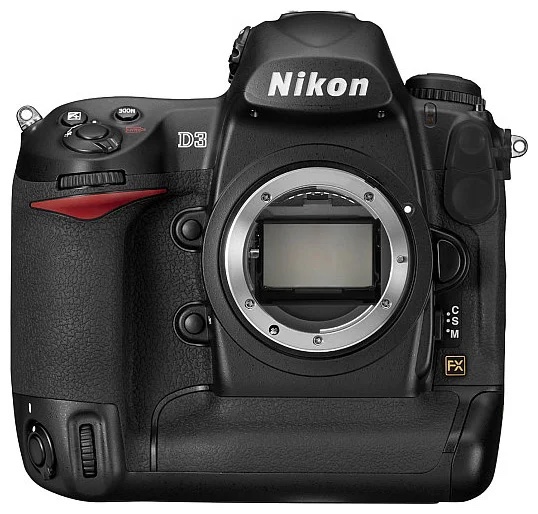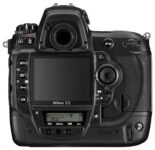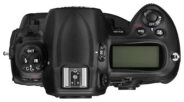Announced
Production status
System
Nikon F system cameras
- Nikkorex F
- Nikkormat EL
- Nikkormat ELW
- Nikkormat FS
- Nikkormat FT
- Nikkormat FT2
- Nikkormat FT3
- Nikkormat FTN
- Nikon D3
- Nikon D3s
- Nikon D3X
- Nikon D4
- Nikon D4s
- Nikon D5
- Nikon D6
- Nikon D600
- Nikon D610
- Nikon D700
- Nikon D750
- Nikon D780
- Nikon D800
- Nikon D800E
- Nikon D810
- Nikon D850
- Nikon Df
- Nikon EL2
- Nikon EM
- Nikon F
- Nikon F100
- Nikon F2
- Nikon F3
- Nikon F4
- Nikon F5
- Nikon F6
- Nikon FA
- Nikon FE
- Nikon FE10
- Nikon FE2
- Nikon FG
- Nikon FG-20
- Nikon FM
- Nikon FM10
- Nikon FM2
- Nikon FM2/T
- Nikon FM3A
- Nikon N2000
- Nikon N2020
- Nikon N4004
- Nikon N4004S
- Nikon N50
- Nikon N5005
- Nikon N55
- Nikon N60
- Nikon N6000
- Nikon N6006
- Nikon N65
- Nikon N70
- Nikon N75
- Nikon N80
- Nikon N8008
- Nikon N8008S
- Nikon N90
- Nikon N90S
Nikon D3
35mm AF digital SLR camera • Discontinued
Specification
| Format: | |
| 35mm full frame | |
Imaging sensor: | 36 × 23.9mm CMOS sensor |
Resolution: | 4256 × 2832 - 12 MP |
Sensor-shift image stabilization: | - |
| Nikon F [46.5mm] | |
| Shutter: | |
Type: | Focal-plane |
Model: | Electronically controlled |
Speeds: | 30 - 1/8000 + B |
| Exposure: | |
Exposure metering: | Through-the-lens (TTL), open-aperture |
Exposure modes: | Programmed Auto |
| Aperture-priority Auto | |
| Shutter-priority Auto | |
| Manual | |
| Physical characteristics: | |
Weight: | 1240g |
Dimensions: | 159.5x157x87.5mm |
Manufacturer description
Nikon UK is pleased to announce the revolutionary Nikon D3 professional Digital SLR that defines a new benchmark in professional photography.
“Nikon has eclipsed the competition with the D3, a cutting edge camera that will change how professional photographers take pictures,” said Robert Cristina, Brand Manager, Nikon Professional Products, Europe. “The incredible speed, resolution and flexibility of the D3 will enable photographers to capture images under conditions previously thought impossible.”
The D3, the result of years of development and feedback from professional photographers, combines many innovative Nikon technologies. These include an exclusive 12.1 effective megapixel FX format (36.0x23.9mm) image sensor with 12-channel read out, a blazing-fast 9 fps frame rate, expandable ISO settings from 200-6400, a completely new 51-Point autofocus system, a 3-inch VGA LCD screen with Live View and a cutting-edge image processing system.
FX Format Image Sensor
The D3 FX format CMOS imaging sensor was designed from the ground up to offer exceptional light transmission properties, so photographers can acquire outstanding image quality even in low light conditions. With a high signal to noise ratio, a pixel pitch 15% larger than competitive cameras, gapless surface micro-lenses and advanced on-chip noise reduction means high-quality images under very low light levels are now possible. The sensor enables an ISO settings range from 200-6400, expandable up to the equivalent of 25,600 or down to 100.
EXPEED Image Processing System
The EXPEED image processing system is at the heart of the D3’s ability to capture and process massive amounts of data at high definition. The EXPEED system includes both hardware and years of Nikon image processing experience. The D3 EXPEED system features 14-bit analog-to-digital (A/D) conversion with 16-bit image processing, both of which contribute to delivering results with Nikon’s signature ‘look and feel’ of rich accurate colours, smooth skin gradations and exceptional detail.
Scene Recognition System
The D3 features a radical new approach to calculating exposures and white balance with intelligent support for Autofocus tracking performance as well. At the heart of the Scene Recognition System is Nikon’s renowned 1005-pixel RGB metering sensor that has been modified to distinguish subjects’ shape and position for improved auto exposure and Autofocus accuracy.
Advanced Autofocus
Building on years of development through both the analogue and digital SLR era, Nikon has once again raised the bar for optical Autofocus systems. The D3 and D300 feature a completely new 51-Point autofocus system designed to acquire and track subjects’ movement more accurately.
The result of intensive studies into how professional sports and news photographers use autofocus, the Multi-CAM3500 AF module features the most AF points ever developed for a SLR camera. The inspired coupling of the AF module with Nikon’s easy-to-use 8-direction multi selector button makes selecting instant individual AF points simple and fast. As one would expect the AF system can be completely customised for every possible shooting condition.
Scorching Speed, Intuitive Response
The image quality of the D3 is combined with outstanding frame rate options. At 9 fps, the D3 is the world’s fastest full format D-SLR1, with an even faster 11fps2 consecutive shooting possible in DX crop mode. A second crop mode is also premiered in the D3, with 5:4 (30mm x 24mm) aspect ratio. Shutter release time lag is an imperceptible 41 milliseconds (CIPA standard), while the image sensor’s integrated high-speed 12-channel readout contributes both to burst speed and Live View performance. The D3 also gets to work quickly; startup time is just 0.12 seconds and mirror black out is only 74ms.
Shutter Unit
The D3 incorporates an all-new Nikon manufactured shutter unit tested to over 300,000 cycles. The shutter blades are constructed from a durable composite KevlarTM and carbon fibre material to deliver unmatched durability and accuracy even in the most demanding of conditions.
Picture Control
Nikon’s new Picture Control system, developed with the help of extensive feedback from photographers, offers improved productivity for JPEG shooters. Picture Control lets users of all levels manage and customise the appearance of their images in camera. This on-board processing saves significant post processing time. With a variety of default settings, photographers can also customize and share settings. Nikon anticipates photographic communities might develop their own Picture Control settings for specific subjects and conditions. Picture Control replaces the existing Colour Mode settings of current Nikon cameras.
High Contrast Subjects, Low Risk
The Active D-Lighting feature of the D3 adds to its JPEG capabilities. Prior to shooting under high contrast conditions, users can apply a pre-set curve that processes images with improved shadow and highlight details, without affecting overall contrast.
Designed for definition
Everything about the D3 is high definition. From the HDMI (High Definition Multimedia Interface) port for output to the latest HD displays to the 3-inch VGA LCD screen with 170-degree viewing angle, images can be played back at very high levels of detail. The new VGA screen also comes into its own when using the new Live View function premiered in the D3 and D300. Unlike other live view technologies, autofocus in possible in all Nikon Live View modes.
Flexible Image Storage
The D3 is the world’s first D-SLR to offer dual CompactFlash card slots for outstanding storage flexibility. A photographer can shoot images to each card one after the other, or simultaneously, as back up. When shooting combined NEF and JPEG files, the NEF image can be written to one card and the JPEG version to the other. Image files can also be selected and copied from one card to the other after shooting.
One Tough Customer
Long the choice of professionals, Nikon SLRs are renowned for withstanding the most challenging conditions. From freezing temperatures of the arctic to the humidity of the rainforest, Nikon’s keep working long after other cameras have ceased to operate, and the D3 is built to continue this tradition. Magnesium alloy is used for the exterior cover, chassis and mirror box, while the seams and buttons of the camera body are sealed against the affects of dust and moisture.
Wireless Networking
Nikon pioneered wireless image transmission. Now, with the new Nikon Wireless Transmitter WT-43, the era of the multi camera network has arrived. Not only can one transmit (‘push’) images to servers and remotely control the camera from afar, the WT-4 also enables remote browsing of the camera’s image thumbnails as well.
In a wireless environment, networks of up to 5 D3 and D300 cameras can be established. At a sports event, for example, photo editors could browse all thumbnails on each camera simultaneously, selecting (‘pulling’) the images they need, while the photographers continue shooting.
Five New NIKKOR Lenses
Five new NIKKOR lenses are also launched today. They include a ground-breaking extreme wide-angle zoom lens, the AF-S 14-24mm f/2.8G ED and a slim line standard zoom, the AF-S 24-70mm f/2.8G ED. Nikon has also launched three all-new super telephoto lenses with VR (Vibration Reduction), the AF-S 400mm f/2.8G ED VR, AF-S 500mm f/4G ED VR and AF-S 600mm f/4G ED VR.
The D3 body measures 159.5 (W) ×157 (H) ×87 (D) mm and weighs 1,390 grams including battery. It will be available in Europe from November 2007.
- As of August 2007.
- Autofocus tracking disabled.
- WT-4 versions vary according to regional/national radio frequency regulations
Similar cameras (2)
35mm full frame • Auto focus • Digital • Singe-lens reflex • Nikon F mount
| Model | Shutter | Metering | Modes | Year |
|---|---|---|---|---|
| Kodak DCS Pro 14n | E, 1/4000 | TTL • OA | PASM | 2002 ● |
| Kodak DCS Pro SLR/n | E, 1/4000 | TTL • OA | PASM | 2004 ● |


